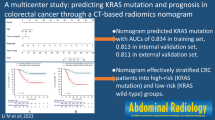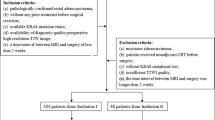Abstract
Objectives
To investigate whether CT-based radiomics signature can predict KRAS/NRAS/BRAF mutations in colorectal cancer (CRC).
Methods
This retrospective study consisted of a primary cohort (n = 61) and a validation cohort (n = 56) with pathologically confirmed CRC. Patients underwent KRAS/NRAS/BRAF mutation tests and contrast-enhanced CT before treatment. A total of 346 radiomics features were extracted from portal venous-phase CT images of the entire primary tumour. Associations between the genetic mutations and clinical background, tumour staging, and histological differentiation were assessed using univariate analysis. RELIEFF and support vector machine methods were performed to select key features and build a radiomics signature.
Results
The radiomics signature was significantly associated with KRAS/NRAS/BRAF mutations (P < 0.001). The area under the curve, sensitivity, and specificity for predicting KRAS/NRAS/BRAF mutations were 0.869, 0.757, and 0.833 in the primary cohort, respectively, while they were 0.829, 0.686, and 0.857 in the validation cohort, respectively. Clinical background, tumour staging, and histological differentiation were not associated with KRAS/NRAS/BRAF mutations in both cohorts (P>0.05).
Conclusions
The proposed CT-based radiomics signature is associated with KRAS/NRAS/BRAF mutations. CT may be useful for analysis of tumour genotype in CRC and thus helpful to determine therapeutic strategies.
Key Points
• Key features were extracted from CT images of the primary colorectal tumour.
• The proposed radiomics signature was significantly associated with KRAS/NRAS/BRAF mutations.
• In the primary cohort, the proposed radiomics signature predicted mutations.
• Clinical background, tumour staging, and histological differentiation were unable to predict mutations.



Similar content being viewed by others

Abbreviations
- AFP:
-
Alpha fetoprotein
- AUC:
-
Area under curve
- CA199:
-
Carbohydrate antigen 199
- CA242:
-
Carbohydrate antigen 242
- CA724:
-
Carbohydrate antigen 724
- CEA:
-
Carcinoembryonic antigen
- CI:
-
Confidence interval
- CRC:
-
Colorectal cancer
- CT:
-
Computed tomography
- EGFR:
-
Epidermal growth factor receptor
- 18F-FDG PET/CT:
-
Positron emession tomography/computerd tomography with 18F-fluorodexyglucose
- FFPE:
-
Formalin-fixed paraffin- embedded
- GLCM:
-
Gray-level co-occurrence matrix
- GLRLM:
-
Gray-level run-length matrix
- ICCs:
-
Intra-/inter-class correlation coefficients
- NCCN:
-
Nationgal comprehensive cancer network
- NGS:
-
Next-generation sequencing
- OR:
-
Odds ratio
- PACS:
-
Picture archiving and communication system
- ROC:
-
Receiver operating characteristic
- SUV:
-
Standardized uptake value
- TPS:
-
Tissue polypeptide specific antigen
- 3D:
-
Three-dimensional
References
van de Velde CJ, Boelens PG, Borras JM et al (2014) EURECCA colorectal: multidisciplinary management: European consensus conference colon & rectum. Eur J Cancer 50:1.e1–1.e34
Cremolini C, Loupakis F, Antoniotti C et al (2015) FOLFOXIRI plus bevacizumab versus FOLFIRI plus bevacizumab as first-line treatment of patients with metastatic colorectal cancer: updated overall survival and molecular subgroup analyses of the open-label, phase 3 TRIBE study. Lancet Oncol 16:1306–1315
Strickler JH, Wu C, Bekaii-Saab T (2017) Targeting BRAF in metastatic colorectal cancer: maximizing molecular approaches. Cancer Treat Rev 60:109–119
Sundar R, Hong DS, Kopetz S, Yap TA (2017) Targeting BRAF-mutant colorectal cancer: progress in combination strategies. Cancer Discov 7:558–560
De Roock W, Claes B, Bernasconi D et al (2010) Effects of KRAS, BRAF, NRAS, and PIK3CA mutations on the efficacy of cetuximab plus chemotherapy in chemotherapy-refractory metastatic colorectal cancer: a retrospective consortium analysis. Lancet Oncol 11:753–762
Van Cutsem E, Lenz HJ, Köhne CH et al (2015) Fluorouracil, leucovorin, and irinotecan plus cetuximab treatment and RAS mutations in colorectal cancer. J Clin Oncol 33:692–700
Peeters M, Oliner KS, Price TJ et al (2015) Analysis of KRAS/NRAS mutations in a phase III study of panitumumab with FOLFIRI compared with FOLFIRI alone as second-line treatment for metastatic colorectal cancer. Clin Cancer Res 21:5469–5479
Barras D, Missiaglia E, Wirapati P et al (2017) BRAF V600E mutant colorectal cancer subtypes based on gene expression. Clin Cancer Res 23:104–115
Douillard JY, Oliner KS, Siena S et al (2013) Panitumumab-FOLFOX4 treatment and RAS mutations in colorectal cancer. N Engl J Med 369:1023–1034
Tabernero J, Lenz HJ, Siena S et al (2015) Analysis of circulating DNA and protein biomarkers to predict the clinical activity of regorafenib and assess prognosis in patients with metastatic colorectal cancer: a retrospective, exploratory analysis of the CORRECT trial. Lancet Oncol 16: 937-948.
Lubner MG, Stabo N, Lubner SJ et al (2015) CT textural analysis of hepatic metastatic colorectal cancer: pre-treatment tumour heterogeneity correlates with pathology and clinical outcomes. Abdom Imaging 40:2331–2337
Kawada K, Nakamoto Y, Kawada M et al (2012) Relationship between 18F-fluorodeoxyglucose accumulation and KRAS/BRAF mutations in colorectal cancer. Clin Cancer Res 18:1696–1703
Miles KA, Ganeshan B, Rodriguez-Justo M et al (2014) Multifunctional imaging signature for V-KI-RAS2 Kirsten rat sarcoma viral oncogene homolog (KRAS) mutations in colorectal cancer. J Nucl Med 55:386–391
Kawada K, Toda K, Nakamoto Y et al (2015) Relationship between 18F-FDG PET/CT scans and KRAS mutations in metastatic colorectal cancer. J Nucl Med 56:1322–1327
Chen SW, Chiang HC, Chen WT et al (2014) Correlation between PET/CT parameters and KRAS expression in colorectal cancer. Clin Nucl Med 39:685–689
Lovinfosse P, Koopmansch B, Lambert F et al (2016) 18 F-FDG PET/CT imaging in rectal cancer: relationship with the RAS mutational status. Br J Radiol 89:20160212
Krikelis D, Skoura E, Kotoula V et al (2014) Lack of association between KRAS mutations and 18F-FDG PET/CT in Caucasian metastatic colorectal cancer patients. Anticancer Res 34:2571–2579
Huang YQ, Liang CH, He L et al (2016) Development and Validation of a Radiomics Nomogram for Preoperative Prediction of Lymph Node Metastasis in Colorectal Cancer. J Clin Oncol 34:2157–2164
Nie K, Shi L, Chen Q et al (2016) Rectal cancer: assessment of neoadjuvant chemoradiation outcome based on radiomics of multiparametric MRI. Clin Cancer Res 22:5256–5264
Gillies RJ, Kinahan PE, Hricak H (2016) Radiomics: images are more than pictures, they are data. Radiology 278:563–577
Zhang B, Tian J, Dong D et al (2017) Radiomics features of multiparametric MRI as novel prognostic factors in advanced nasopharyngeal carcinoma. Clin Cancer Res 23:4259–4269
Coroller TP, Grossmann P, Hou Y et al (2015) CT-based radiomic signature predicts distant metastasis in lung adenocarcinoma. Radiother Oncol 114:345–350
Vallières M, Kay-Rivest E, Perrin LJ (2017) Radiomics strategies for risk assessment of tumour failure in head-and-neck cancer. Sci Rep 7:10117
Liu Z, Zhang XY, Shi YJ et al (2017) Radiomics analysis for evaluation of pathological complete response to neoadjuvant chemoradiotherapy in locally advanced rectal cancer. Clin Cancer Res. https://doi.org/10.1158/1078-0432.CCR-17-1038
Aerts HJ, Velazquez ER, Leijenaar RT et al (2014) Decoding tumour phenotype by noninvasive imaging using a quantitative radiomics approach. Nat Commun 5:4006
Boonstra K, Weersma RK, van Erpecum KJ, Rauws EA, Spanier BW, Poen AC (2013) Population-based epidemiology, malignancy risk, and outcomeof primary sclerosing cholangitis. Hepatology 58:2045–2055
Reyes O, Morell C, Ventura S (2015) Scalable extensions of the ReliefF algorithm for weighting and selecting features on the multi-label learning context. Neurocomputing 161:168–182
Vandenberghe R, Nelissen N, Salmon E et al (2013) Binary classification of 18 F-flutemetamol PET using machine learning: comparison with visual reads and structural MRI. Neuroimage 64:517–525
Roffo G, Melzi S, Cristani M (2015) Infinite feature selection. Proceedings of the IEEE International Conference on Computer Vision 4202–4210
Liu S, Liu S, Ji C et al (2017) Application of CT texture analysis in predicting histopathological characteristics of gastric cancers. Eur Radiol. https://doi.org/10.1007/s00330-017-4881-1
Shiri I, Rahmim A, Ghaffarian P, Geramifar P, Abdollahi H, Bitarafan-Rajabi A (2017) The impact of image reconstruction settings on 18F-FDG PET radiomic features: multi-scanner phantom and patient studies. Eur Radiol. https://doi.org/10.1007/s00330-017-4859-z
Baldus SE, Schaefer KL, Engers R, Hartleb D, Stoecklein NH, Gabbert HE (2010) Prevalence and heterogeneity of KRAS, BRAF, and PIK3CA mutations in primary colorectal adenocarcinomas and their corresponding metastases. Clin Cancer Res 16:790–799
Esteva A, Kuprel B, Novoa RA et al (2017) Dermatologist-level classification of skin cancer with deepneural networks. Nature 542:115–118
Anthimopoulos M, Christodoulidis S, Ebner L, Christe A, Mougiakakou S (2016) Lung pattern classification for interstitial lung diseases using a deep convolutional neural network. IEEE Trans Med Imaging 35:1207–1216
Emblem KE, Pinho MC, Zöllner FG et al (2015) A generic support vector machine model for preoperative glioma survival associations. Radiology 275:228–234
Funding
This study has received funding by the National Natural Science Foundation of China (grant numbers 81227901, 81771924, 61231004, 81501616, 81671851, 81527805, 81501549, 81671829 and 81671757), the National Key R&D Program of China (grant numbers 2017YFA0205200, 2017YFC1308700, 2017YFC1309100, and 2017YFC1308701), the Science and Technology Service Network Initiative of the Chinese Academy of Sciences (grant number KFJ-SW-STS-160), the Instrument Developing Project (grant number YZ201502), the Beijing Municipal Science and Technology Commission (grant number Z161100002616022), and the Youth Innovation Promotion Association CAS.
Author information
Authors and Affiliations
Corresponding authors
Ethics declarations
Guarantor
The scientific guarantor of this publication is Jie Tian.
Conflict of interest
The authors of this manuscript declare no relationships with any companies, whose products or services may be related to the subject matter of the article.
Statistics and biometry
No complex statistical methods were necessary for this paper.
Informed consent
Written informed consent was waived in this study.
Ethical approval
Institutional Review Board approval was obtained.
Methodology
• retrospective
• diagnostic experimental
• performed at one institution
Electronic supplementary material
ESM 1
(DOCX 555 kb)
Rights and permissions
About this article
Cite this article
Yang, L., Dong, D., Fang, M. et al. Can CT-based radiomics signature predict KRAS/NRAS/BRAF mutations in colorectal cancer?. Eur Radiol 28, 2058–2067 (2018). https://doi.org/10.1007/s00330-017-5146-8
Received:
Revised:
Accepted:
Published:
Issue Date:
DOI: https://doi.org/10.1007/s00330-017-5146-8



